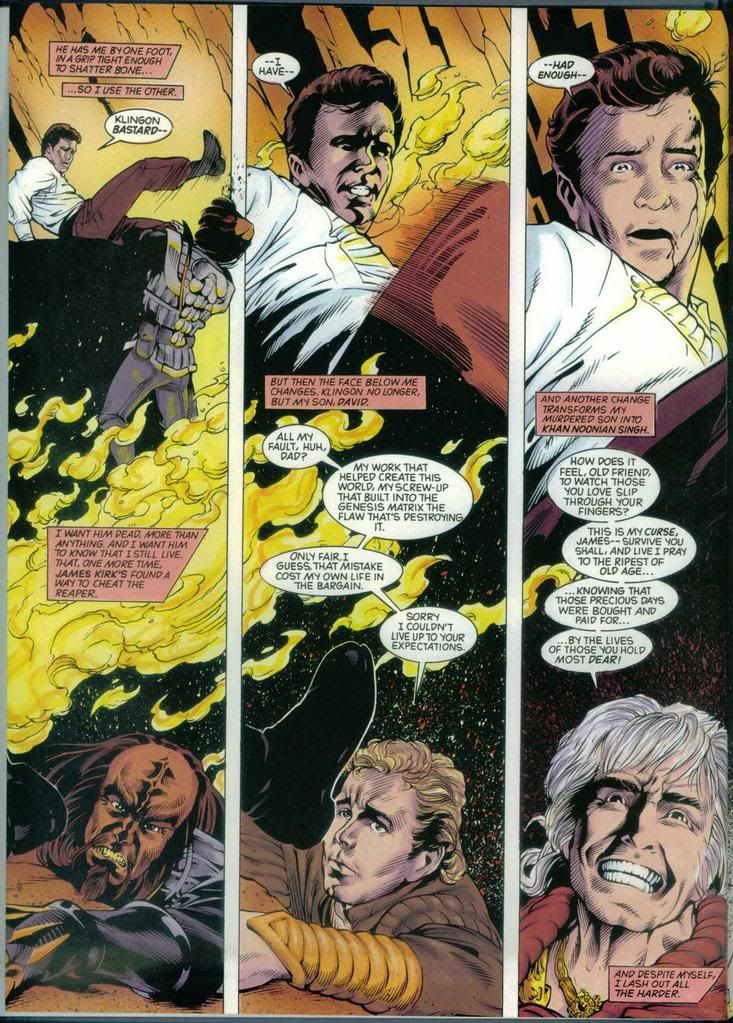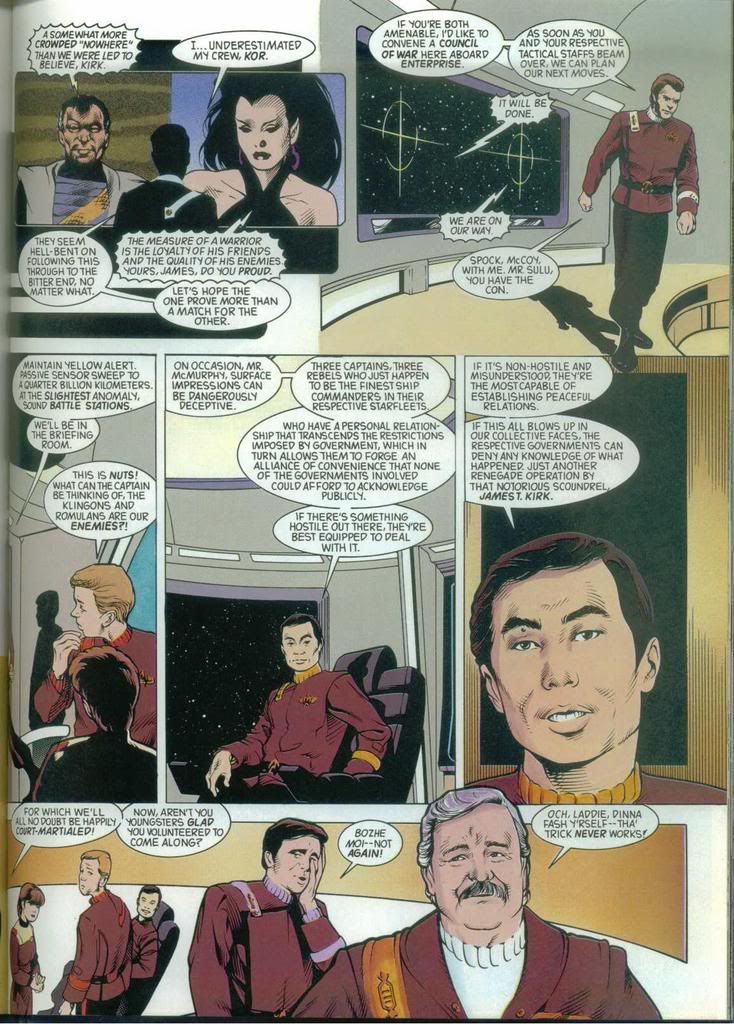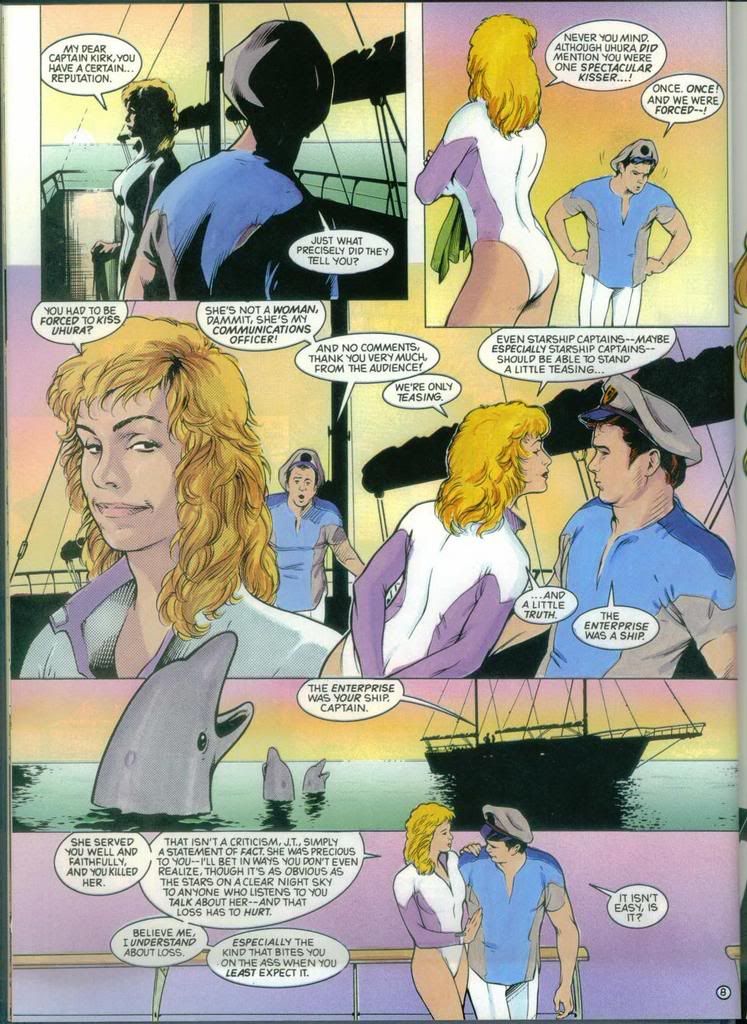Kind of rah-rah, and nothing really groundbreaking (Kirk loves his ship? You don't say!), but sounds promising, right?
Credits first: Debt of Honor was written by Chris Claremont, pencilled by Adam Hughes, inked by Karl Story, colored by Tom McCraw, and lettered by Bob Pinaha. Hughes and Story acknowledge the contributions of Gordon Purcell on layouts and Brian Stelfreeze and others (presumably) on other aspects of the art.
Let's start with writer Chris Claremont's plot.
Kirk's been having dreams about kicking Christopher Lloyd in the face (Chris Sims would be proud) on the Genesis Planet. This would be fine, except that the Klingon then turns, in rapid succession, into David Marcus, Khan, and the original Enterprise. Ultimately, Kirk himself becomes the Enterprise, blazing a fiery trail across the Genesis Planet's sky.

Back in the real world, he's out on the high seas with Dr. Gillian Taylor, the Mary Sue from Star Trek IV, watching her bond with the two humpback whales and a few dolphins. The new Enterprise is in Spacedock, for once not assigned to any missions, so Kirk's setting up some side action for himself. (No, not like that, although the topic does not go unaddressed.)
Seems that at various points in his career -- as a lieutenant on the Farragut, right after "The Doomsday Machine," and shortly after The Motion Picture, Kirk encountered a nasty extragalactic race that would strike swiftly and then disappear, leaving little for the Federation to investigate. The attacks tended to follow major celestial events like the Planet Killer, V'Ger, and now the Whale Probe, so Kirk anticipates a new incursion and wants to stop it. His plan involves old Klingon and Romulan acquaintances as well.
Once everyone's introduced and the Enterprise is underway -- and believe me, that takes a lot of the story -- the plan is, as Bill Cosby might have put it, to walk down nothing but dark alleys with ten-dollar bills hanging out of one's pockets. Naturally, the critters attack, rescue missions are performed, sacrifices are made, and the Enterprise warps out just ahead of the big explosion.
Although the main plot doesn't really kick in until a little past the halfway point, that's not really why this book exists. As a 25th-anniversary story, it incorporates as many Original Trek elements as it can, and also includes a couple from The Next Generation (Chateau Picard wine, Klingon discommodation). The book features about a dozen Original Trek characters in cameos or other small roles, along with additional Easter-egg references to Trek novelists. Again, that's all fine on its face.
There are new characters too, and I include in that the new take on Jame Finney, daughter of Kirk's disgraced friend Ben Finney from "Court-Martial." Here, twenty years after the episode, she's pushing thirty as a lieutenant j.g., but she acts like a cadet. She and the other Claremontian junior officers are all aw-shucks, self-deprecating, happy-to-be-here, and of course all supremely competent because otherwise they'd be on some other ship.
The most prominent new character is T'Cel, introduced during the Farragut scenes as a Vulcan scientist assigned to help Lt. Kirk with damage control. T'Cel fights off the nasty aliens along with Kirk, saving his life before giving herself up to the Romulans. T'Cel and Kirk have a liaison, as the kids say, the details of which are strongly implied even as they seem logistically creepy. (For one thing, Kirk is apparently unconscious -- shades of Devin Grayson!) T'Cel pops up whenever Kirk encounters the critters or their handiwork, and she's there for the fireworks at the end too. Essentially, she's the Catwoman/Sans Serif of this story.
As you can tell, the script has a lot of information to dump, and its problem lies in its reliance almost exclusively on dialogue (including log entries) to do it. Characters devote paragraphs to their own motivations and their suppositions about their colleagues. One scene even ends with Bones talking to himself for an extended period -- which, considering the in-jokey nature of the script, is probably yet another obscure reference; but it made me realize the device had gone too far. What's worse, characters talk to each other about things they surely know and/or have discussed ad infinitum over the past twenty-five years. Bones even exposits to Spock about the latter's history with his father. Everyone except the Vulcans sounds wildly unnatural. While this may be Claremont's conscious effort to make up for whole episodes where Sulu, Uhura, et al., only spouted jargon, again it makes you wonder why people don't just get bored and walk away.
And the accents -- good Lord, the accents! It's not that Bones sounds like Rogue and Chekov like Colossus, but Claremont wants there to be no doubt about where they're supposed to hail from. Maybe that's an in-joke too. Thankfully, the Klingons don't start talking Russian back to Chekov until late in the book.

The problem is that as an adaptation of filmed works, DOH (I love that acronym) is stuck in "movie mode." If adaptations of plays can feel too stagebound, this one is too screen-bound. It does sport some nice panel layouts and sequential storytelling, but their structure strains under the weight of all that dialogue.
This page, for example: Spock and Bones pedeconference to the Bridge from their chess match on the Rec Deck. Big panels alternate with smaller ones, there's that nice bisection of the two-shot panel with the turbolift inset, and there's plenty of room for word balloons. However, is their conversation really necessary to the story, considering the book's past the 1/3 mark and we're stlll not out of Spacedock? Also, the dense dialogue and the relative lack of movement within "scenes" (i.e., panels) gives the impression that the characters are just taking a lazy trip to the Bridge, and might as well fill in any rookie readers on the way. If this were a movie, it would be Clerks.

Overall, the book is somewhat indulgent. I particularly wonder if the two-page spread of our friend the yardmaster cooing over the Enterprise wouldn't have worked better as a silent image, so that the reader could enjoy it on its own terms. Every Star Trek movie wants to do its own version of the Motion Picture-esque beauty pass, but this one wants to be more efficient, imparting a little (unnecessary) backstory as well.

However, having all of those elements (dialogue, travel pod, huge starship) competing for your eyes' attention on the same visual level leaves the spread feeling disorganized. To be sure, we read from top to bottom and left to right, so we may well be drawn to the yardmaster's first word balloon, and from there follow his soliloquy counterclockwise to the travel pod and then "up" to the Enterprise -- but the largest single image is the Enterprise, and I don't think the balloons can compete with it. A silent spread of the ship, even with the travel pod for perspective, would have been more dramatic.
Still, it wouldn't have let Claremont name-check previous captains (no love for Captain Spock's tenure?) or give his yardmaster the hardly-unexpected personality trait of starship love. If the yardmaster's soliloquy was meant to emphasize a) the history of NCC-1701 and b) the transference of same to NCC-1701-A, I think that even gets a little muddled. Seeing as how everyone connected with either Enterprise loves boldly going, etc., and talks about it All The Time, I don't think we need to be reminded by this guy.
But the whole book is like that, full of little connect-the-dots moments that celebrate how great it is for all of Star Trek to fit together so seamlessly, even when apparent contradictions (smooth vs. bumpy Klingons?) crop up. The book is loaded with dissertations on Trek minutiae, presented virtually in that form. It's not so much a work of fiction as it is a thesis. It's almost its own Wiki.
And again, the problem isn't so much that Claremont seeks to make these connections, but that he has the characters spell them out in dialogue. Our old friend the Omniscient Narrator would have been a great help here, but that would have meant introducing a new voice into the mix, and it's pretty obvious that Claremont wants to build this story on the familiar voices of the cast. The great irony is that he has those characters speak very fannish sentiments, when using an omniscient narrator in this case would have been, almost by definition, incorporating the voice of the fan.
However, that would apparently have violated the filmic nature of the story. Obviously, when filmed Trek needs narration, it turns to log entries and other in-story forms of exposition. Here, though, Debt of Honor doesn't realize it can be a comic first and a Trek story second. Accordingly, it's only too happy to give everyone a chance to monologue, regardless of how it makes them sound. To be fair, I don't recall too many Star Trek comics using an anonymous narrator, but I also don't think those other comics were as verbose as this one.
In this respect, Debt of Honor is a narratively thin work, limited to (wait for it...) "two-dimensional thinking." In one scene, Lt. Finney stops by Bones' office to talk about the Klingon experts that can't make the trip, and naturally mentions everyone's qualifications. Today's superhero books, though they avoid anonymous captions and thought balloons, might well have replaced that exposition with an overlaid panel styled like a library-computer dossier. That's an extra layer of graphic storytelling unique to comics, familiar to Trekkies, and suited to the situation.
As it is, the script appears to have a love-hate relationship with its underlying sentiments. It loves its characters, and wants them to live and breathe and speak in their authentic voices, but in practice it makes them sound incredibly self-absorbed. Maybe this is a Claremont trademark, and maybe he's even making fun of his own tendencies. I'll leave that to the more knowledgeable among you.
Boy, that Hughes/Story/McCraw et al. art is gorgeous, though. The playfulness of this page particularly reminds me of Hughes' Justice League America work.

Clearly the 23rd Century has been good to Dr. Taylor, and of course Kirk always gets treated well by Trek artists. Debt of Honor's saving grace is that while it might be padded by dialogue, at least it has page on page of reverential art.
(* For some reason I think it was delayed until the summer of 1992, but I'm not absolutely sure about that. I know the paperback came out in '92.)



